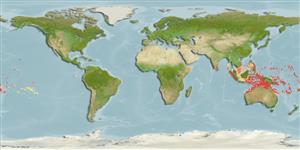Common names from other countries
>
Syngnathiformes (Pipefishes and seahorses) >
Syngnathidae (Pipefishes and seahorses) > Syngnathinae
Etymology: Corythoichthys: Greek, korys, korythos = helmet + Greek, ichtys = fish (Ref. 45335).
More on author: Ramsay.
Issue
The species Corythoichthys waitei Jordan & Seale, 1906 is considered as valid in Eschmeyer (CofF ver. Mar. 2011: Ref. 86697) following Allen & Erdmann (2008: Ref. 74959).
Environment: milieu / climate zone / depth range / distribution range
Écologie
marin récifal; profondeur 20 - 68 m (Ref. 9710), usually ? - 68 m (Ref. 37816). Tropical; 16°N - 23°S
Western Central Pacific: Borneo to Samoa, north to Marshall and Mariana Islands, south to Rowley Shoals and New Caledonia; throughout Micronesia.
Taille / Poids / Âge
Maturity: Lm ? range ? - ? cm
Max length : 16.0 cm SL mâle / non sexé; (Ref. 1602)
Épines dorsales (Total): 0; Rayons mous dorsaux (Total): 26-32; Rayons mous anaux: 4.
Adults occur in shallow sandy or mixed sand, rubble, or coral areas of reef flats and lagoons, also sometimes on seaward reefs (Ref. 1602). Ovoviviparous (Ref. 205). The male carries the eggs in a brood pouch which is found under the tail (Ref. 205). Males may be brooding at 6.5-7.0 cm SL. Usually in pairs or may form small aggregations (Ref 90102).
Life cycle and mating behavior
Maturité | Reproduction | Frai | Œufs | Fécondité | Larves
Monogamous mating is observed as both obligate and genetic (Ref. 52884). Male carries the eggs in a brood pouch (Ref. 205).
Dawson, C.E., 1985. Indo-Pacific pipefishes (Red Sea to the Americas). The Gulf Coast Research Laboratory Ocean Springs, Mississippi, USA. (Ref. 5316)
Statut dans la liste rouge de l'IUCN (Ref. 130435)
CITES (Ref. 128078)
Not Evaluated
Menace pour l'homme
Harmless
Utilisations par l'homme
Pêcheries: sans intérêt; Aquarium: Aquariums publics
Plus d'informations
RéférencesAquacultureProfil d'aquacultureSouchesGénétiqueElectrophoresesHéritabilitéPathologiesTraitementMass conversion
Outils
Articles particuliers
Télécharger en XML
Sources Internet
Estimates based on models
Preferred temperature (Ref.
115969): 25.3 - 28.7, mean 26.9 (based on 122 cells).
Phylogenetic diversity index (Ref.
82804): PD
50 = 0.5002 [Uniqueness, from 0.5 = low to 2.0 = high].
Bayesian length-weight: a=0.00037 (0.00016 - 0.00085), b=3.18 (2.99 - 3.37), in cm Total Length, based on LWR estimates for this (Sub)family-body shape (Ref.
93245).
Niveau trophique (Ref.
69278): 3.2 ±0.2 se; based on diet studies.
Résilience (Ref.
120179): Haut, temps minimum de doublement de population inférieur à 15 mois (Preliminary K or Fecundity.).
Fishing Vulnerability (Ref.
59153): Low vulnerability (10 of 100).
